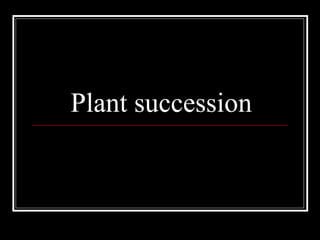
Plant succession
- 2. The Concept Succession is the natural, orderly change in plant and animal communities that occurs over time. If left undisturbed, an open field may become an "aging" forest in 150-300 years. However soil conditions, climate, permafrost, topography, and natural and unnatural forces may affect the pattern of succession
- 3. Weather, fire, flood, insects, and human activity can disrupt the forest, altering the pattern of succession
- 4. The Stages
- 5. Herb Stage In this stage it contains seed plants whose stems wither away to the ground each winter. insects and small rodents feed on the grasses, herbaceous plants, and seeds As the diversity of plants increases so does the variety of wildlife species.
- 6. Shrub Stage usually low woody plants with several permanent stems instead of a single trunk Larger variety of wild-life attracts predators
- 7. Young Forest Stage the quantity and diversity of shrubs and herbaceous plants decreases With less variety in food available, the number of wildlife species decreases. birds of prey nest in the trees of a young forest
- 8. Mature Forest Stage hardwood trees begin to die, opening the canopy for the growth of spruce Shrubs return and make more food and cover available to songbirds, game birds, and rodents.
- 9. Climax Forest Stage dead trees called snags provide homes for woodpeckers and other cavity-nesting birds. Porcupines, squirrels, spruce grouse, and several songbird species are typical of old stands of spruce trees.
- 10. Types of Succession Primary Secondary Allogenic Autogenic Progressive Retrogressive
- 11. Primary Establishment of plants on land previously not cultivated.
- 12. Secondary Invasion by plants on land that that was previously vegetated. Possible causes include natural or human such as fire logging, cultivation or hurricanes
- 13. Allogenic Change in Environmental conditions E.g.. Salt marsh to woodland. The environmental changes the composition of the plant community
- 14. Autogenic Where both plant community and environment change Caused by the activities of plants over time E.g.. Eruption of Mt. St.Helens
- 15. Progressive Where community becomes more complex with time Contains more species Contains more biomass over time.
- 16. Retrogressive The community regresses. Becomes more simplistic Contains fewer species and less biomass Some retrogressive successions are allogenic in nature E.g. Introduction of grazing animals results in degradation of farmland.
- 17. The Facilitation Model "pioneer species" establish a presence on the site of a disturbance. They modify a site, for instance, by regenerating the soil with organic material making the area more attractive for invasion by other species. Eventually, new species move in, edging out the pioneers. This process may repeat itself several times, until the ecosystem reaches the climax stage.
- 18. The Tolerance Model all species involved in succession are equally capable of establishing themselves on a recently disturbed site but those capable of attaining a large population size quickly are likely to become dominant Unlike the facilitation model, the tolerance model does not depict earlier inhabitants as preparing the site biologically. this model is more akin to natural selection.
- 19. The Inhibition Model all species have equal opportunity to establish populations after a disturbance some of the early species actually make the site less suitable for the development of other species An example of this is when plants secrete toxins in the soil, thus inhibiting the establishment and growth of other species
- 20. Climax When a biological community reaches a state of stability and is in equilibrium with environmental conditions Dominant species in a climax community are those that are tolerant of the biological stresses that come with competition frequent enough events of disturbance within small sections of the biological community may prevent climax from even occurring Once reached change will slow down bringing an end to the stages of succession. Climax remains a theoretical notion.
- 21. What can cause Succession Seismic Events: earthquakes, tidal waves, or volcanic eruptions hurricanes or tornadoes. the movement of glaciers or even of plates in Earth's crust wildfires or sudden infestations of insects Humans causes such as plowing up ground, logging, clearance for construction even by causing explosions on a military reservation or battlefield
